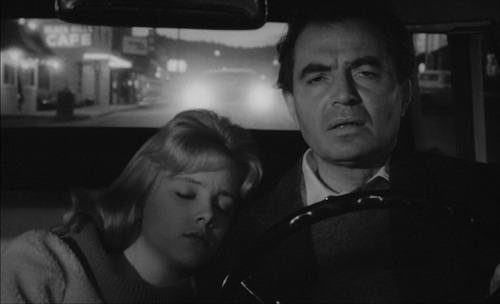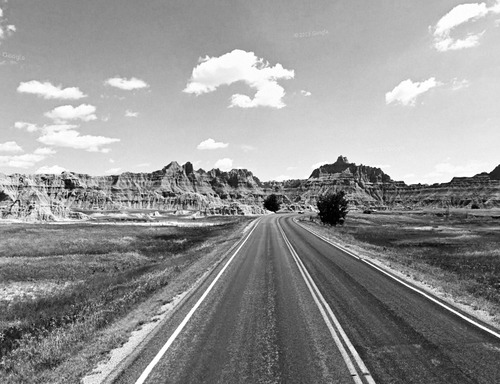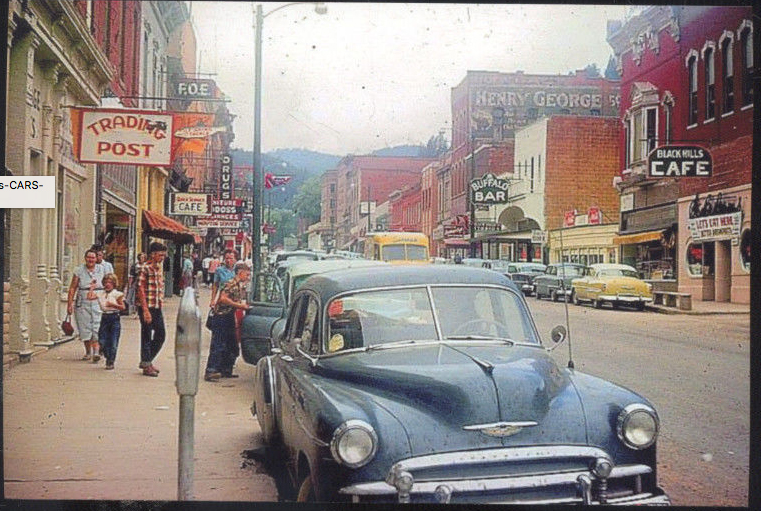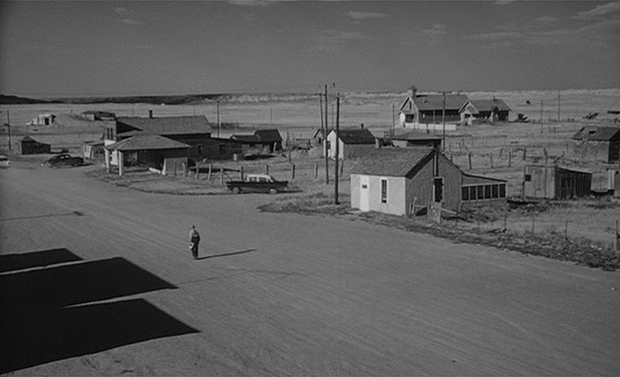Unexpected Lolita Locations - Identifying the Black Hills Cafe and the Badlands of South Dakota
(We Are Not in the Southwest)

Go to TOC for this film ( (which has also a statement on purpose and manner of analysis and a disclaimer as to caveat emptor and my knowing anything authoritatively, which I do not, but I do try to not know earnestly, with some discretion, and considerable thought).
This post continues from Lolita rear screen projection Location Shots 271-285 – Guess What, When They're on Their Way to the Enchanted Hunters Hotel in the White Mountains, They're in the Black Hills of South Dakota
When Humbert and Lolita are in the southwest, where are they? Arizona? Are they even in the southwest, where we expect them to be? Where they are given as being in the book and screenplay?
Fleeing Beardsley, Humbert and Lolita take off for California. Shots 406 through 410 (only one location of which is identified, that being in Newport, RI) are of highways backed by verdant foliage, then in shot 411 we are suddenly in a desert place with decidedly badland features in the distance. This is where the viewer may begin to wonder if they are being followed. By shot 412, Humbert seems to be aware as well, and though not much background location is shown, some features remind me of the Black Hills near Mount Rushmore. We already know that the rear screen projection location shots, on the way to the Enchanted Hunters Hotel, occur in the Black Hills of South Dakota. I have been able to confirm this with landscape features, signage, and buildings.
Then what do we see in shot 414?

If we take a close look at the one sign clearly observable in the rear screen projection background, it reads Black Hills Cafe. Kubrick finally comes right out and says, "Black Hills. That's where you are." Beyond is what appears to be a GEM movie theater sign.
The next scene takes place at a gas station, shot in England, then we are back to the badlands where Humbert becomes absolutely confident they are being followed.
From the first time I saw Lolita on I assumed that location shots 411, 423, 427 and the rear screen projection shots 424-431 were taken in the Painted Desert/Petrified Forest area of Arizona. I've been through there three times. I've photographed the hills there. I should have known better.
Because finally I had a moment of lucidity and it hit me that there is nothing really like these formations in the Painted Desert, not on this scale, and the road that Humbert and Lolita drive in the is not at all like the road that takes one through the Painted Desert. This twisty-turny highway is not there.
These monstrous features looked like, instead, the Badlands of South Dakota.
These are the Badlands of South Dakota.

Above is shot 427 from Lolita. Below is a Google maps screengrab of the Badlands.

This is not an exact match but these are most definitely the Badlands of South Dakota where Humbert and Lolita have their tire blow out, pull over to the side of the road, and the car that has been behind them pulls over as well then turns and drives away. They would be on Highway 240, which carries on the 24/42 theme Kubrick has used throughout the film, the Haze household's number being 242, the room where they stayed at the Enchanted Hunters Hotel being 242. They are unable to escape this numerological prison that haunts Humbert in the novel as 342. They are unable to give fate the slip.
A mystery was which Black Hills Cafe this is? There were four Black Hills Cafes that appeared to have been owned by the same family. I researched and found pics of the cafes in Deadwood and Custer and they didn't match, but the mountains at Deadwood were close. I'd not seen what the cafes would have looked like in NewCastle, Wyoming and Chamberlain, SD but the mountains in the background from NewCastle looked less promising and the surrounding landscape for Chamberlain wasn't a match. Another town with the right kind of mountains in relation to Main Street was Hill City, South Dakota. I only accidentally looked at Hill City, South Dakota because I thought a photo presented it as having a Black Hills Cafe when instead it was a Hill City Cafe. So no match there. I should have downloaded that photo as it's no longer on the web. Hill City's Main Street has changed dramatically, it's a town that has almost completely replaced the buildings along Main Street.
Below is the Black Hills Cafe that was in Deadwood. Not the place. The sign just misses, and the buildings are all physically connected whereas in the film many of the buildings/shops are not connected.

So close! It was driving me nuts. I knew that none of the original Black Hills Cafes were the cafe in the movie. And I knew that cafe in the movie had to be in the Black Hills.
Let's take another look. Here's how the Black Hills Cafe is represented in the film.
Driving away from that cafe, we see a little house with a porch and a white picket fence. I've outlined it in red.
I went back one more time to examine Google maps, and look what I found in Hill City (where there used to be a GEM theater). That house with the covered porch and picket fence. It has been left standing, as well as a larger building in the background that was neighboring the faux Black Hills Cafe in the film, just beyond it (now the Jon Crane Gallery at 256 Main). Just as in the film, there is the house with the little attic window and the covered porch and they have even retained the white fence. It doesn't have a historic designation and yet for some reason it has been pristinely preserved. Thus we're able to identify Hill City having been a location for a Lolita rear screen projection .
White picket fences are used throughout Lolita, ever visually repeating the theme of Humbert's cage, the starling's cage, and the cage of fate as well.
For some reason, Kubrick placed the Black Hills Cafe in Hill City, where there was no Black Hills Cafe, but there was a Hill City Cafe that had a very similar sign. A Black Hills Cafe sign would have had to have been installed for this shoot of a few seconds, unless there was doctoring of the film itself, and by appearances I imagine instead a sign was installed. This is no casual use of a rear screen projection .
I should add that the Hill City Cafe currently in Hill City is not the same cafe/location as an the old Hill City Cafe. The Hill City Cafe now in operation in Hill City does give itself as having been in operation for over a 100 years, but I read that the location they're now in was apparently once the Powder Horn Restaurant.
So, I'd finally found where they had shot the Black Hills Cafe as being in Hill City. I was determined to find where they were in shot 411, which I knew had to be also in the Badlands. I had looked a couple of times at Scenic, South Dakota, thinking it was the most probable location, but nothing seemed to fit except for one perhaps building and I wasn't sure about it. I went back to the town and found a church in the background.
I found this church online, an old photo taken by photographer, Paul Snyder, that looked like the same church, with a porch entry cover removed, in the above screengrab. I had already looked for the church in Scenic and it wasn't there. I tried again, and no luck.
But I was certain that had to be the church. I went back and looked at a building that had previously caught my eye and realized my suspicion that this building was the same one as in the curve of the road that opens the shot. The Standard station that was opposite is no longer there.
On the Google screengrab you can see a bit of what this part of the highway is called, which is Bombing Range Road. During WWII, 500 square miles of Oglala Sioux Badlands was designated as a bombing area, and clean-up is still ongoing. A KELO report states "Between the years of 1942 and 1967, millions of pounds of munitions were dropped on the land. In fact, thousands of unexploded shells are still turning up."
If you go to Google Maps and zoom in on the building you will see the windows in the little building, now shuttered.
The arched roof of a Quonset hut, to the left, is barely visible in the film beyond the Standard station, and that building is also still there.

I returned to the film and found another building, that would have once been a church, and realized it was still in Scenic.
The porch covering for the entry of what was once the Catholic Church is no longer there, but the Tatanka Trading Post is the same building as the one circled in red.
Looking at the trading post in Google Maps, I noticed not far from it was an old stone building. It seemed to me we might be able to see this in the film, and we do. It's the building circled in blue. One can barely recognize it due a tree in front now, but it was originally the town jail.
Shot 411 is the one in which the audience becomes aware that Humbert and Lolita are perhaps being followed.

Though all other primary identifying features in the film are gone, including the church Paul Snyder had photographed, we can now positively identify this as having been filmed in Scenic, South Dakota, which skirts the southwest edge of the Badlands. The shot is of the car going down Main Street, off Highway 44.
There are a few Kubrick shooting locations I've found that had been previously unidentified, of which I'm particularly proud for having located them. The Badlands and Black Hills location shots I count among them. Sometimes one puts the energy into doing a thing that's really idiotic, like hunting down a location shot, because you have the feeling you might be able to do it and no one else likely could. There's something about the location that says, "Find me, I know you can do it". Though I must say in cases like this it's because no one else would want to pursue the task.
Why the Black Hills and Badlands?
I stated in the prior post, on the use of the Black Hills on the way to the Enchanted Hunters Hotel:
The Enchanted Hunters Hotel has been presented as being possibly in the White Mountains of New Hampshire due happenings in Nabokov's novel. Because of the White Mountains, New Hampshire used to be known as the "Switzerland of America". It's when Humbert and Lolita are at the Enchanted Hunters Hotel that Nabokov, in his novel, has Humbert beginning to operate under the delusion/suspicion that his Swiss Uncle, Gustave Trapp, who had similar tastes to Humbert, has begun following them. He thinks he's seen him at the hotel. Kubrick plays with opposites, negative and positive counterparts as in the black and white squares of a chess board, and it's my reasoning that the Black Hills relate to the White Mountains in this way because the Black Hills have also been called the "Switzerland of America". The story within the story has Lolita and Humbert crossing over into the underworld, as represented by the Black Hills and the Enchanted Hotel. If we examine Kubrick's other movies we see parallel scenarios such as with the Overlook in The Shining, Somerton in Eyes Wide Shut, and the Lyndon estate in Barry Lyndon which has for one of its settings a garden that uses monuments to depict the story of Aeneas' descent into the underworld, a journey the garden visitor is intended to re-enact. I elaborate on these parallels elsewhere.
Kubrick, now, in this second sojourn, unites the Black Hills with the white mountains.
The film stock and contrast make the rock formations of the South Dakota Badlands have the appearance of a white mountain range.
We are, with Lolita and Humbert, at the world's edge, a subject I'll cover in another post.
The novel Red Alert, that Dr. Strangelove was based on, was published in 1958. The NYT published in 1962 that at that time Kubrick and Peter Bryant, the author, had been for two years working on a treatment, which means that Kubric was working on it while also working on Lolita. Let's take another look at the scene in Lolita that takes place in the Badlands of Scenic, South Dakota, which was likely filmed in 1961. It is shot 411, our first shot of the desert on their western trip. At the very beginning of shot 411 we see Humbert and Lolita at the junction of Railway Street/1st Street and Bombing Range Road, Bombing Range Road there turning into Main Street. They pull onto Main Street, where it has merged with Bombing Range Road. It is in this shot that we first see the two-toned car pull out from a side road and follow them.
Kubrick played with permutations of numbers, and I think we have here the well-known CRM-114 which in Dr. Strangelove is the radio equipment that is destroyed on the bomber. Because of its destruction the crew doesn't receive the recall code, OPE (a permutation of POE, Peace on Earth, Purity of Essence), that would stop their dropping the atomic bomb on Russia.
Below is a range of the action in shot 411, showing Bombing Range Road. The red path is the one that Humbert and Lolita's car takes. The blue is the path of the car that follows them. I place this here so you can get a visual of Bombing Range Road, so called because of the govt confiscating 500 square miles of Oglala Sioux land during WWII for bombing practice, an area that is still being cleaned up, where live bombs are still occasionally found.
Shot 412 then shows Lolita playing at being the harem girl, covering her face. A brief few bars of Hollywood style Middle Eastern music accompanies to confirm she is portraying herself as a harem girl. They are driving through the Black Hills. I've been in the area and the scenery looks identical to what one starts getting near Mount Rushmore. Mountain goats roam the steep sides of the hills.
I've pointed out in my analysis of A Clockwork Orange that we see CRM-114 not only in the serum used to inject Alex, but we see its permutation in shot 380 with the parachutists leaping from the Nazi plane numbered 0141. It's my belief that, in conjunction with the Beethoven, this ends up programming Alex for his leap out of the window. It's also my belief that CRM, for Kubrick, may represent the Hebrew charem/cherem, one of the definitions of which is "physical (as shutting in) a net...doomed object" also devoted/consecrated to religous purposes, especially destruction. I'm talking about an overall idea that suits well Dr. Strangelove's CRM-114 that isolated the jet by blocking any transmissions not prefixed by a set 3 letter code, and ultimately the jet is blocked completely by the destruction of the receiver. This isolation is the key aspect and is important in The Shining as well, the Torrances cut off by the winter storm. Lolita, as well, is isolated from society by Humbert.
Harem, as in a harem of women, derives from the same.
1630s, from Turkish harem, from Arabic haram "wives and concubines," originally "women's quarters," literally "something forbidden or kept safe," from root of harama "he guarded, forbade."
Online Etymology Dictionary
Then this from Wikipedia:
The word has been recorded in the English language since 1634, via Turkish harem, from Arabic ḥaram "forbidden because sacred/important", originally implying "women's quarters", literally "something forbidden or kept safe", from the root of ḥarama "to be forbidden; to exclude". The triliteral Ḥ-R-M is common to Arabic words denoting forbidden. The word is a cognate of Hebrew ḥerem, rendered in Greek as haremi (ha-re-mi) when it applies to excommunication pronounced by the Jewish Sanhedrin court; all these words mean that an object is "sacred" or "accursed".
In shot 411 we have the bombing range. In shot 412 we have the harem (ChRM) girl. Thus do we have a variation on CRM-114 in Lolita.
March 2016. Approx 2900 words or 6 single-spaced pages. A 22 minute read at 130 wpm.
Go to Table of Contents of the analysis (with supplemental posts)
Link to the main TOC page for all the analyses